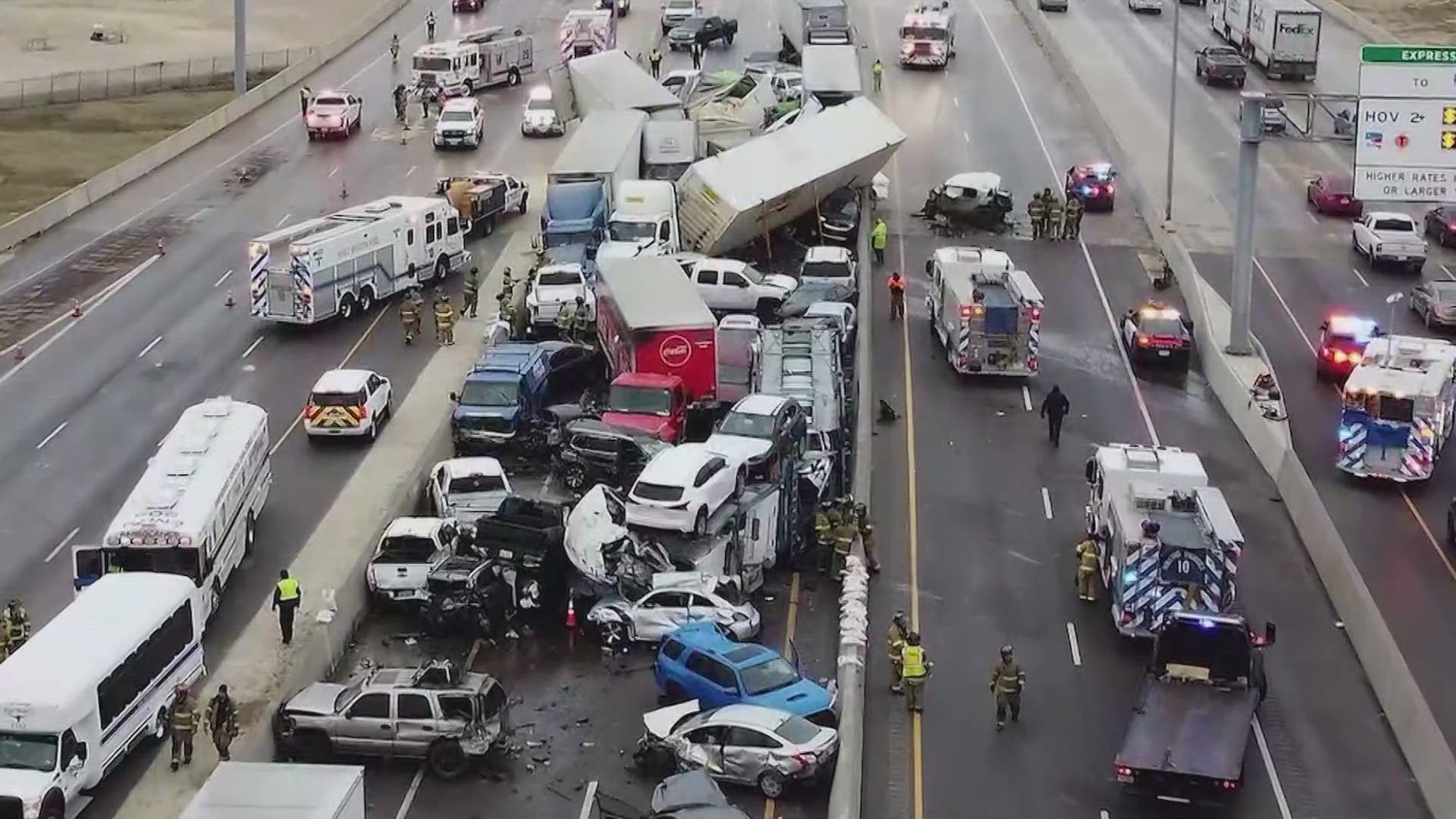FORT WORTH, Texas — The NTSB said Thursday that the company responsible for maintaining Interstate 35 West in Fort Worth failed to address icy roadway conditions during the 2021 winter storm, contributing to the massive pileup on the roadway.
The crash stretched about 1,100 feet and involved commercial and passenger vehicles. From the crash, six people were killed, two of which were pedestrians who were stuck on the road after they had exited their vehicles. The other deaths involved people who remained in their vehicle during the pileup.
In the days before the crash, the NTSB stated the area had incurred 36 hours straight of below-freezing temperatures.
The company responsible for maintenance and operations on the roadway, North Tarrant Express Mobility Partners Segment 3 (NTEMP S3) had pre-treated two southbound lanes with liquid brine 44 hours prior to the pileup, and some sections were spot-treated with salt on Feb. 11, but the NTSB said NTEMP S3 didn't treat the elevated portion of the highway where the crash occurred.
"NTSB investigators found that NTEMP S3’s roadway monitoring process was deficient because, as precipitation and freezing temperatures continued and conditions deteriorated on the morning of Feb. 11, company personnel did not identify the elevated portion of I-35W as needing additional de-icing treatment, which left the roadway surface icy," the NTSB stated in a news release.
Investigators also determined drivers traveling too fast for the icy road conditions contributed to the crash severity, the NTSB added.
"As a result of the investigation, the NTSB is recommending that Texas install variable speed-limit signs, add sensors to reduce response times to weather-related hazardous road conditions and provide training to Texas toll road facilities on how to better respond to winter storms," the NTSB detailed.
Heath Stone got a call when the crash happened.
"It was my wife," said Stone, "And the only words were I've been in a bad wreck."
Stone had not put two and two together at first when he learned about the I-35W crash. However, eventually, it dawned on him that his wife takes that portion of the interstate to work. After finding a place of care for their children, Stone drove to the crash scene he was hearing about over his communications devices. As an emergency responder, he even made phone calls to a coworker to learn more about what could possibly be his wife's crash, which she mentioned during their phone call. It didn't sound good at all.
"I started getting some notifications that there was an even bigger wreck now, possible. They're saying 50, 60-something cars," said Stone, I was like, now that's scene seems a little spacey. It's 50, 60 cars. And then it started making more sense when he started to say where the location was."
After driving to I-35, Stone then witnessed what he called the worst multi-vehicle crash in his career as a first responder. What he saw made his heart sink, and even moreso, what he heard.
"People screaming, car horns going off, smoke in the air, all the smells. Cold, freezing sirens, it was overwhelming," Stone said.
Stone found his wife, who had climbed out her back car window to safety. Her vehicle was part of the wreckage and almost completely unrecognizable. He asked her about her injuries and learned she was OK. So, naturally, Stone went into emergency responder mode and immediately started helping rescue others.
"My kids got to keep their mom and see their mom. And some children didn't," said Stone, "And so, it strikes me deep now."
TEXPress, who maintain toll lanes on I-35W released a statement saying they are disappointed and strongly disagree with the conclusions of NTSB's report.
"Given the extraordinary circumstances, we are confident in the actions taken by the company," the statement read. "In particular, we want to reaffirm that we fully activated our winter storm program leading up to and throughout the winter storm event, and that we coordinate with TxDOT on best practices for snow and ice control in North Texas."
TEXPress stated that they pre-treated the corridor well within the prescribed pre-treatment window and that during the storm, their crews monitored the entire length of I-35W's corridor, including elevated areas, for potential ice formation.
"Our crews patrolled in trucks with salt to de-ice identified areas and to test the highway around the clock," the statement detailed. "NTE35W technicians drove through the area of the accident within 45 minutes before the first indication of rain in the incident areas. We pretreated all sections of I-35W--as well as the rest of the 40 miles of highway corridors we operate and maintain in North Texas."
Additionally, TEXPress stated that their technicians did not see any previous precipitation at the scene of the accident within 45 minutes of the first sign of rain in that area.
"Hours earlier, we had posted dynamic signage within the vicinity of the accident site, warning drivers of icy conditions and to drive with caution," the statement concluded. "We also had deployed permanent signage warning drivers that bridges could ice in cold weather."
The full highway investigative report can be found here.

